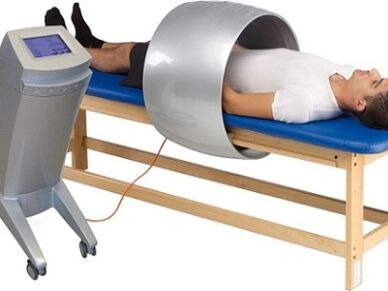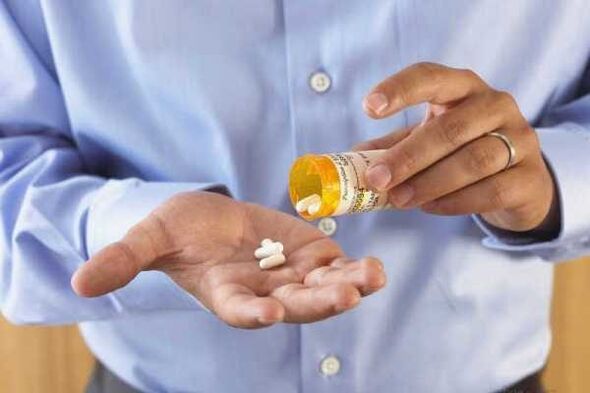Prostatitis is one of the most common diseases among men.At any stage, the pathology causes enormous discomfort and significantly worsens the general state of health.Drug treatment for prostatitis can effectively combat the disease.However, to carry it out correctly and safely, you must consult a doctor.
Existing treatments

Various therapy methods are used to treat prostatitis.The choice always depends on the type and severity of the disease.There are the following ways to get rid of prostatitis:
- medical;
- surgical;
- physiotherapeutic.
Pay attention!Traditional medical methods are often used at home.
These include herbal baths and compresses.However, this therapy has extremely low effectiveness and can only be used as an auxiliary therapy.
Usually prostatitis is treated comprehensively.Drug therapy and one or more minimally invasive therapy methods are used simultaneously.Surgical intervention is only used in extremely severe cases when other methods are ineffective.
Medication
Drug treatment of the prostate is used at any severity of the disease and covers various manifestations of the pathology.Some medications can also be used as prophylaxis.Medications are also used as maintenance therapy during surgery.
The main purpose of taking medication is to relieve the inflammatory process and eliminate infections in bacterial prostatitis.Even during complex drug therapy, drugs help to normalize the functioning of the gland.
Surgical
The surgical method of therapy does not always mean radical measures to remove the gland.Safe, minimally invasive surgical methods are coming to the fore.
Surgical methods include:
- TUR (transurectal resection of the gland).It is performed using a resectoscope.Depending on the type of inflammation, the procedure can involve removing either part of the gland or the entire prostate.
- adenectomy or prostatectomy.Open surgery using a conventional scalpel.The procedure is characterized by a long rehabilitation period.
- Cryodestruction.The inflamed area of the gland is exposed to liquid nitrogen.
- Laser therapy.Used mainly for chronic prostatitis.A laser beam is used to evaporate moisture in the inflamed area of the gland.In this case, damaged tissue is burned out.The method helps to improve the regenerative properties of the organ.
The choice of a specific method of surgical intervention is individual, based on the severity of the disease and the general condition of the body.
Physiotherapeutic

Physiotherapeutic methods include the following manipulations:
- Transuretal microwave therapy.The prostate is exposed to high temperatures.This is done using special external or invasive devices.During treatment, excess fluid evaporates from the organ and it shrinks, reducing pressure on the bladder.
- Exposure to ultrasonic waves.The treatment is carried out using special devices that allow you to influence only the prostate.The therapy is painless.
- Magnetic laser induction therapy.The inflamed gland is exposed to laser and magnetic waves at the same time.The method allows you to relieve pain symptoms, increase blood flow to the organ, and also accelerate tissue regeneration processes.The method also increases the effectiveness of the medications used.
- Balloon dilatation.A small dilator with an inflatable balloon at the end is inserted into the urethra.The device protects the bladder and excretory tract from increased pressure from the prostate on them.
- Stenting.A stent is inserted into the urethra to protect the ducts from being crushed by the enlarging gland.
- Reflexology.The method includes acupuncture and electropuncture.The procedures significantly improve blood circulation in the organ and accelerate metabolism and cell regeneration.
- Hirudotherapy.Can only be done with medicinal leeches.Increased blood flow to the gland is ensured.
- Massage.The procedure allows you to increase blood circulation and metabolism.Massage also eliminates stagnation of glandular secretions and increases the effectiveness of medications.
Physiotherapeutic therapy methods are always used in conjunction with medical treatment of the prostate.
Main groups of drugs
Drug treatment of prostatitis includes several groups of drugs.This includes:

- antibacterial agents;
- nonsteroidal anti-inflammatory drugs;
- antispasmodics or muscle relaxants;
- alpha blockers;
- immunomodulators;
- painkillers;
- hormones;
- peptides or biological regulators;
- Sedatives or anti-anxiety medications.
Medications from several groups are always prescribed at the same time.This is necessary not only to relieve the symptoms of the pathology, but also at the same time to eliminate the main cause of the disease and normalize the functioning of the organ.
Medications can be in the form of tablets, intramuscular injections, ointments, creams, or rectal suppositories.
Antibacterial agents
Antibacterial drugs or antibiotics are used to destroy pathological bacteria, the growth of which has triggered an inflammatory process in the gland.
The standard medication duration is 3 weeks.However, taking antibiotics leads to disruption of the microflora of the gastrointestinal tract.Therefore, they can only be used after tests have confirmed the presence of a viral infection.
Nonsteroidal anti-inflammatory drugs
Drugs in this group are used when the main cause of prostatitis is not a bacterial infection.
If the effectiveness of antibiotics is low, anti-inflammatory non-steroidal drugs can also be prescribed.
Since drugs of this type have negative effects on the liver and stomach, they cannot be taken continuously for more than 3-5 days.
The greatest effectiveness of drugs is observed when they are used at the beginning of the treatment of exacerbations.
Antispasmodics or muscle relaxants
Used for emergency relief of muscle spasms in exacerbation of prostatitis accompanied by prolonged urinary retention.
Medications work quickly, but only for a short time.
Alpha blockers
Medication helps restore the body's excretory function and relieve muscle spasms.
The duration of continuous use is 7-8 months, as the drugs have cumulative effectiveness.
Immunomodulators
They serve to generally strengthen the body, as well as increase its resistance to various infections.
When using antibiotics, medication is required.
Painkillers
Inflammatory processes in the prostate are always accompanied by pain.In this case, problems can occur both when urinating or during an erection as well as when resting.
Medical microenemas have the greatest effectiveness and minimal side effects.
Hormones
Medicines of this type can only be used as prescribed by a doctor and only if the cause of prostatitis is a hormonal imbalance in the male body.
Hormonal drugs are often prescribed for advanced prostatitis or the development of carcinogenic processes.
Uncontrolled use of hormonal drugs can lead to pharmacological castration.
Peptides or biological regulators
Peptides are natural biological products made from the glands of cattle.The most effective are lyophilisates based on bovine prostate.
Such drugs provide general strengthening of the body, stimulate blood circulation, improve the quality and quantity of sperm, and relieve swelling of the gland.
Sedatives
Problems with the prostate cause not only physical but also enormous psychological problems in men.Therefore, drug treatment of prostatitis often requires the use of sedatives.
Sedatives can be used in cases of severe mental disorders and the ineffectiveness of conventional sedatives.However, it is only sold with a doctor's prescription.

Advantages and disadvantages of therapy
Drug treatment of the disease has advantages and disadvantages compared to other methods.The benefits of taking medication include:
- high efficiency of therapy;
- rapid relief of pain symptoms;
- rapid and complete restoration of glandular function.
Pay attention!An undisputed advantage of the drug therapy method is its ease of use.
Prescription medications can be easily taken and used anywhere, while physical therapy requires a mandatory visit to the doctor's office or extended periods of solitude for prostate self-massage.
Conclusion
The disadvantage of drug therapy is the presence of many contraindications and side effects.However, if you follow medical recommendations, the negative consequences of therapy will be minimized.





















